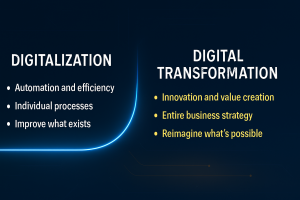
Achieving organizational goals in a digital-first world demands seamless alignment between business strategy and IT delivery. Bridging this gap ensures that every technology investment propels business success. Here’s how to navigate this critical transformation.
The Business-IT Connection
A business strategy defines the long-term direction of an organization, while IT delivery operationalizes this vision through technological solutions. Achieving alignment requires translating strategic goals into IT initiatives that drive measurable outcomes. Success lies in ensuring that IT delivery is not just a support function but a key enabler of business growth.
Steps to Align Business Strategy with IT Delivery
1. Clarify Vision and Objectives
- Understand Strategic Goals: Start by dissecting the business strategy, identify core objectives, market position, and competitive drivers.
- Define IT Outcomes: Align these goals with actionable IT deliverables. For example, a strategy prioritizing customer satisfaction might translate into implementing AI-driven customer support or a mobile-first platform.
2. Foster Collaboration
- Engage Stakeholders: Include leaders from both business and IT teams early in the planning process to ensure mutual understanding and commitment.
- Enhance Communication: Create consistent communication channels to share progress, troubleshoot challenges, and refine priorities collaboratively.
3. Develop an IT Roadmap
- Strategic Alignment: Build an IT roadmap that prioritizes projects by their alignment with business goals and impact potential.
- Plan Resources: Secure the right budget, talent, and tools to execute the roadmap effectively, ensuring every initiative is sustainable and scalable.
4. Leverage Agile Practices
- Iterative Development: Use agile methodologies to enhance flexibility. Iterative development cycles enable IT teams to quickly respond to changing business needs.
- Cross-functional Teams: Blend expertise from business and IT teams to ensure that solutions are practical, feasible, and aligned with strategic goals.
5. Invest in Future-ready Technology
- Strategic Evaluation: Choose technologies that scale with growth, integrate seamlessly, and offer long-term value.
- Embrace Innovation: Keep an eye on emerging technologies, such as AI, blockchain, edge computing that can redefine business operations and deliver a competitive edge.
6. Implement Change Management
- Prepare for Change: Communicate the value of IT initiatives clearly to all stakeholders, addressing concerns and resistance.
- Support Employees: Provide training to empower teams to adopt new tools and systems effectively, ensuring a smooth transition and long-term adoption.
7. Measure and Refine Performance
- Set KPIs: Define metrics that gauge IT performance against strategic goals. For example, track customer engagement, cost savings, or operational efficiency.
- Continuous Improvement: Use data-driven insights to refine processes and technologies, ensuring sustained alignment between business and IT.
Navigating Common Challenges
1. Bridging the Business-IT Divide
- Mutual Education: Equip business leaders with IT knowledge and IT teams with business acumen to foster alignment.
- Designate Liaisons: Assign business analysts or IT liaisons to facilitate communication and translate priorities effectively.
2. Managing Complex Projects
- Structured Methodologies: Apply proven frameworks like PMBOK, PRINCE2, or Scrum to navigate complexity and deliver results on time.
- Risk Management: Proactively identify and mitigate risks, adapting plans as necessary to stay on track.
3. Synchronizing Expectations
- Realistic Timelines: Set achievable deadlines by balancing business urgency with IT feasibility.
- Transparent Reporting: Maintain open communication about progress, challenges, and adjustments to build trust and confidence.
Conclusion
The transformation of business strategy into IT delivery is not a one-time exercise but an ongoing commitment. By clarifying objectives, fostering collaboration, leveraging agile practices, and embracing innovation, organizations can bridge the divide between strategic aspirations and technological execution.
Overcoming common hurdles through education, structured project management, and transparency ensures smoother transitions and higher success rates. Ultimately, strategic alignment between business and IT doesn’t just enhance operational efficiency, it drives long-term success and positions the organization as a leader in a dynamic digital economy.









